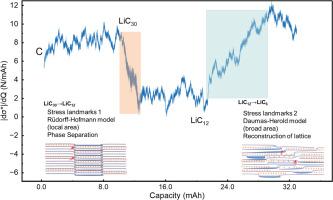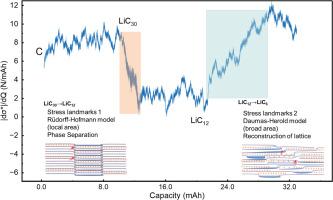电极尺度应力表征揭示石墨阳极Li+插入机理
IF 20.2
1区 材料科学
Q1 CHEMISTRY, PHYSICAL
引用次数: 0
摘要
作为锂离子电池的首选负极材料,深入了解石墨的锂化机制对于提出新的优化策略至关重要。在本研究中,创新地将传统上通过x射线衍射和中子粉末衍射等技术获得的晶格演化信息转化为应力信号进行分析,为Li⁺在石墨中的插层机理提供了力学见解。采用蒙特卡罗方法模拟了石墨颗粒组件的动态锂化行为,并结合原位x射线衍射和高分辨率透射电镜,系统地阐明了锂化过程中的机械-电化学映射关系。石墨的锂化过程表现为三个不同的力学阶段:C→LiC30、LiC30→LiC12和LiC12→LiC6。值得注意的是,在第一/第二阶段和第二/第三阶段之间的过渡期间,观察到明显不同的力学特征,这偏离了理论预测。进一步分析表明,前者源于快速的相分离过程,而后者是由锂嵌入引起的晶格重构驱动的。这两种现象分别可以用r本文章由计算机程序翻译,如有差异,请以英文原文为准。


Operando electrode-scale stress characterization revealing the Li+ insertion mechanism of graphite anode
As a preferred anode material for lithium-ion batteries, a deeper understanding of the lithiation mechanism in graphite is essential for advancing novel optimization strategies. In this study, the lattice evolution information traditionally obtained through techniques such as X-ray diffraction and neutron powder diffraction is innovatively translated into stress signals for analysis, providing mechanical insights into the Li⁺ intercalation mechanism in graphite. The dynamic lithiation behavior of graphite particle assemblies is simulated using the Monte Carlo method, and combined with in situ X-ray diffraction and high-resolution transmission electron microscopy, the mechanical–electrochemical mapping relationship during lithiation is systematically elucidated. The lithiation process of graphite exhibits three distinct mechanical stages: C→LiC30, LiC30→LiC12, and LiC12→LiC6. Notably, during the transitions between the first/second and second/third stages, significantly differentiated mechanical signatures are observed, which deviate from theoretical predictions. Further analysis reveals that the former originates from a rapid phase separation process, while the latter is driven by lattice reconstruction induced by lithium intercalation. These two phenomena can be well explained by the Rüdorff–Hofmann interlayer intercalation model and the Daumas–Herold domain wall migration mechanism, respectively. The presence of such stage-specific mechanical responses suggests that distinct intercalation mechanisms govern different stages of graphite lithiation. The experimental findings presented in this work contribute to a multidimensional and comprehensive understanding of the graphite lithiation mechanism.
求助全文
通过发布文献求助,成功后即可免费获取论文全文。
去求助
来源期刊

Energy Storage Materials
Materials Science-General Materials Science
CiteScore
33.00
自引率
5.90%
发文量
652
审稿时长
27 days
期刊介绍:
Energy Storage Materials is a global interdisciplinary journal dedicated to sharing scientific and technological advancements in materials and devices for advanced energy storage and related energy conversion, such as in metal-O2 batteries. The journal features comprehensive research articles, including full papers and short communications, as well as authoritative feature articles and reviews by leading experts in the field.
Energy Storage Materials covers a wide range of topics, including the synthesis, fabrication, structure, properties, performance, and technological applications of energy storage materials. Additionally, the journal explores strategies, policies, and developments in the field of energy storage materials and devices for sustainable energy.
Published papers are selected based on their scientific and technological significance, their ability to provide valuable new knowledge, and their relevance to the international research community.
 求助内容:
求助内容: 应助结果提醒方式:
应助结果提醒方式:


